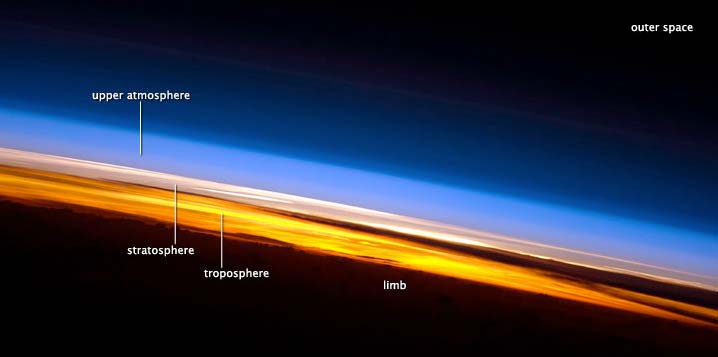Earth's Colorful Atmospheric Layers Photographed from Space

A spectacular new image taken by astronauts on theInternational Space Station shows the various layers of Earth's atmosphere duringsunset over the Indian Ocean.
A brilliant sequence of colors in the image denotes each ofthe layers of Earth's atmosphere, which are visible here because the picturewas taken while the space station hadan edge-on, or limb, view of the Earth. From this vantage point, the Earth'scurvature can also be made out.
The troposphere ? the lowest layer of Earth's atmosphere andthe one in which humans dwell and weather occurs ? appears in deep oranges andyellows. The troposphere can extend from the planet's surface to a heightbetween 3.5 to 12.5 miles (6 and 20 km).
This lowest layer contains more than 80 percent of the massof the atmosphere and almost all of the water vapor, clouds, and precipitation.
Several dark cloud layers are visible within this layer inthe image. Variations in the colors are due mainly to varying concentrations ofeither cloudsor aerosols (airborne particles or droplets).
Next up is the stratosphere, which appears as a pink towhite region above the clouds. This atmospheric layer generally has little orno clouds and extends up to approximately 30 miles (50 km) above the Earth?ssurface.
The stratosphere is also home to the layerof ozone that protects the Earth's surface and the creatures that live onit from the sun's harmful ultraviolet rays.
Breaking space news, the latest updates on rocket launches, skywatching events and more!
Above the stratosphere, blue layers mark the upperatmosphere (including the mesosphere, thermosphere, ionosphere, and exosphere)as it gradually fades into the blackness of outer space.
The astronaut aboard the space station was facing west whenthey snapped this picture. Astronauts in low-Earth orbit see 16 sunrises andsunsets every day due to their high orbital velocity (more than 17,000 mph, or28,000 kph).
- Images:Earth From Above
- Top 10Views of Earth From Space
- Elvesand Sprites Caught Dancing Near the Edge of Space

Space.com is the premier source of space exploration, innovation and astronomy news, chronicling (and celebrating) humanity's ongoing expansion across the final frontier. Originally founded in 1999, Space.com is, and always has been, the passion of writers and editors who are space fans and also trained journalists. Our current news team consists of Editor-in-Chief Tariq Malik; Editor Hanneke Weitering, Senior Space Writer Mike Wall; Senior Writer Meghan Bartels; Senior Writer Chelsea Gohd, Senior Writer Tereza Pultarova and Staff Writer Alexander Cox, focusing on e-commerce. Senior Producer Steve Spaleta oversees our space videos, with Diana Whitcroft as our Social Media Editor.
